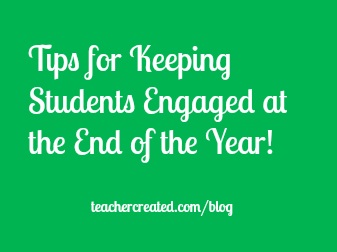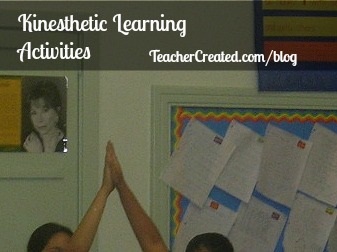
It is hard to believe, but it’s already May! Report cards will be due soon, promotion ceremonies must be planned, and end-of-the-year testing is upon us. So what is a teacher supposed to do when the only thing greater than the looming to-do list is the students’ desire to be on summer vacation? Here are some tips to keep students engaged in curriculum without adding too much to our already overextended schedules.
Leverage the Power of Technology:
There are so many awesome online resources available that can easily be aligned to our curriculum and common core standards.
 Find a site that works for you and sign up for some computer lab time! A well-placed webquest, multimedia presentation project, or interactive online experience can solidify concepts in new ways without demanding a ton of prep work or grading. Some of my favorite online and computer resources are:
Find a site that works for you and sign up for some computer lab time! A well-placed webquest, multimedia presentation project, or interactive online experience can solidify concepts in new ways without demanding a ton of prep work or grading. Some of my favorite online and computer resources are:
- Prezi or PowerPoint: Students can create presentations covering any subject they’re learning! Creating and delivering presentations is an important language arts skill for students to learn and it can do double duty if they are presenting information related to science, history, literature, or other content areas. In my experience, upper-grade students love to create cool presentation design and the accountability of presenting to their peers spurs them on to do their very best work. Note: Prezi is a little more complicated and requires an email address to sign up, so it is most appropriate to use with older students who are highly computer proficient. I suggest you make some teacher prezis for lessons before you teach students to make them. PowerPoint may be the best option for starting out this kind of project.
- Starfall: This is a great resource for lower-grade students. There are a variety of phonics and literacy resources for students to work at their own level.
- Arcademic Skill Builders: This website is dedicated to engaging and exciting K-8 students in math, literacy, geography, and more all in a safe environment! You can use this site for free, but if you sign up for the subscription, you can customize game content, track student achievement, and help students earn awards for performance.
Looking for more ways to incorporate computer projects into your classroom? Check out Teacher Created Resources Computer Projects for Grades 2-4 and Computer Projects for Grades 5-6.
Leave us a comment and share your favorite online resources for students.
Tip: Be sure to research the site, understand how it works, and check to make sure it won’t be blocked from your school’s internet filter before you take your class to the lab.
Get Kids Moving with Kinesthetic Learning Activities:
We all know that many kids learn best from active, hands-on activities, but we don’t always have the budget or time to create elaborate, new kinesthetic activities. Worry not, my fellow tired teacher, I recently attended a Kagan Cooperative Learning seminar where I picked up fun strategies for getting students up and moving that can be used across subjects and grade levels. These are definitely easy and fun tools to keep in your pedagogical toolbox!
- Quiz-Quiz Trade: Students make flashcards (or are provided with flashcards) for academic vocabulary or facts that you are learning in class. Each student needs to have a set of flashcards that match everyone else’s set, but shuffled up in different orders. Then, everyone stands up and picks a partner. It is best if you have a big open space in the classroom or outside. I love to take my class out to the field next to my classroom on a beautiful spring day. Partner 1 quizzes partner 2 on just one flashcard, and partner 2 is praised or coached by partner 1. Next, they switch and Partner 2 quizzes Partner 1 on one flashcard with praise or coaching. Once both have had a chance to ask and answer one card, they trade the used cards and find new partners. The whole class continues to mingle for an allotted amount of time quizzing, trading, and finding new partners. I love this activity because it gets students’ blood flowing while also developing vocabulary and study skills! It can work in almost any subject.
- 4 Corners: The teacher asks students to stand in the middle of the room and then announces “corners” and a question with four possible answers. For example, the teacher says that the four corners of the room represent four characters from Charlotte’s Web: Charlotte, Wilbur, Templeton, and Fern. Then, the teacher asks, “Which character from the book can you relate to most?” After a short “think time,” students go to the corner labeled with the character that they can relate with most. Once there, they must find a partner and discuss their reasoning.
- Stand up, Hand up, Pair up: When reinforcing concepts and continuing to develop academic vocabulary, it is helpful for students to have a chance to discuss their ideas, but all too often I find the same hands raised and the same students dominating the conversation. To get everyone in the class talking, try asking students to walk around the room shaking hands and greeting their classmates. This helps mix up the usual friend-partners and work on social skills. After a minute or so, tell everyone to stand with their hand in the air and high five one person near them. The high five partners turn into discussion partners. Once the partners are picked, the teacher asks a question and each partner has an allotted amount of time to answer. After both have answered, students sit down and the teacher calls on a few students to re-tell their partner’s answers. This gives all students a chance to speak, listen, and participate actively.
Check out more Teacher Created Resources Creative Classroom Ideas! I especially love the hands-on projects found in each section of the literature guides, like this one about the novel Holes. What are your favorite kinesthetic learning strategies? Leave us a comment and share the love!
Emily Guthrie has taught English Language Arts in grades 6-12 for the last 7 years. She lives with her husband, Chris, and toddler Miles in sunny Southern California. Emily loves creating curriculum, cooking, running, and blogging.

